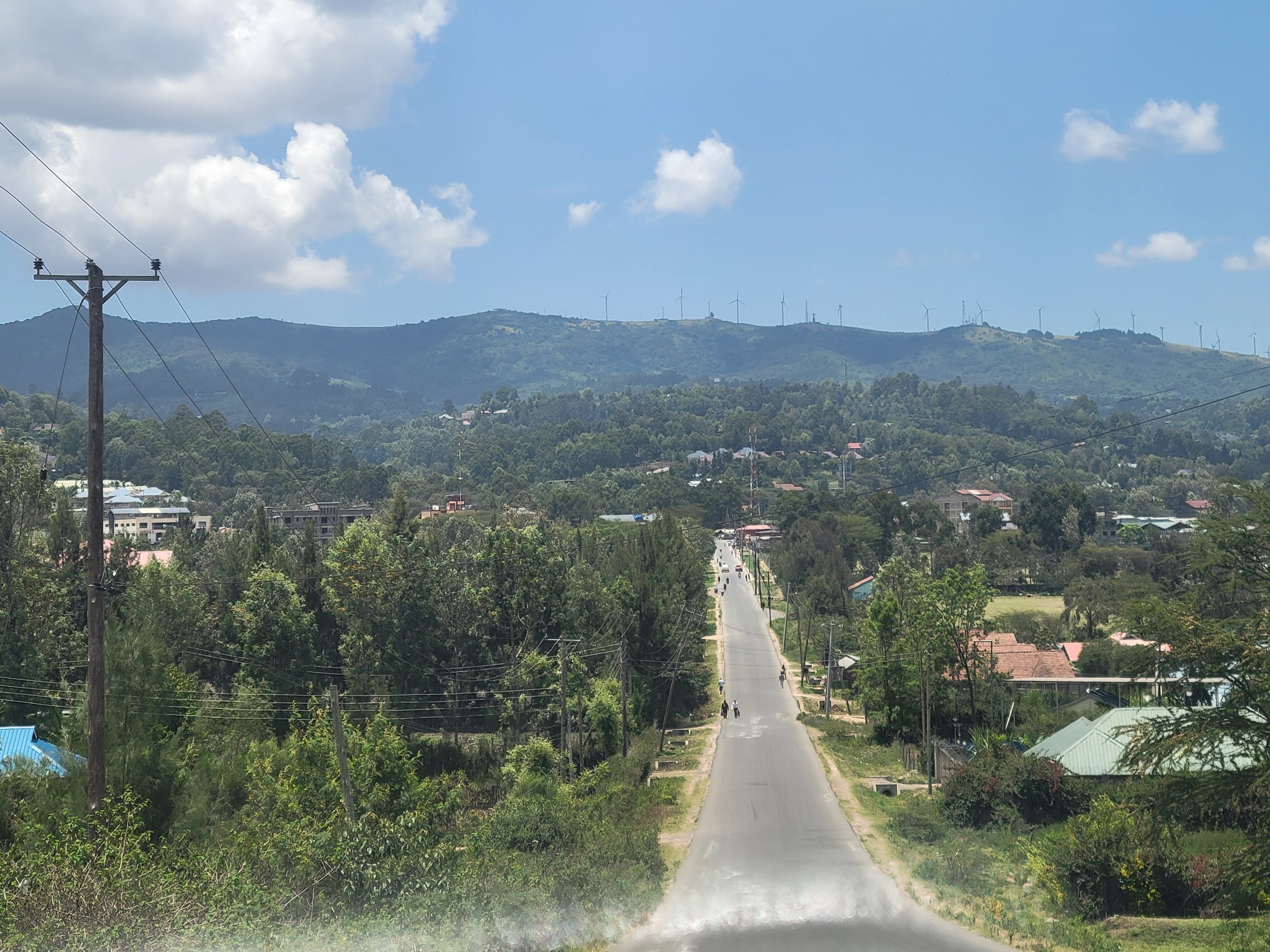Ilmerijo and Tulivu
Today we were off to Ilmerijo Primary for our first stop. Above is the road to the school. The Ngong Hills are in the background. Those of you who have read or seen Out of Africa may remember their mention. Note all the wind turbines on top. They weren’t there when Karen Blixen (Isak Dinesen) wrote the book.
Ilmerijo is the most recently added to our porridge program. Virginia, Claudia, and I have been involved with the school for several years. They recently changed head teachers, so we are building a relationship with Margaret, the new head. She welcomed us warmly.
Ilmerijo has had a porridge program in place sponsored by a couple different organizations. Both organizations pulled out of their agreements, for different reasons, starting the final term of this school year.
Virginia visited the school a few weeks ago and learned about the lack of porridge. She reached out to the rest of our team and we agreed to step in. Money was transferred and Virginia delivered a month’s supply the day after she met with Margaret.
The kids get gethiri for lunch, provided by still another organization, via the government. Gethiri is a mix of corn and beans boiled until done. It is filling and provides some nutrients. But a lot of the kids aren’t getting food at home, either for dinner or breakfast. So they are really hungry when they get to school. This inhibits the learning process, to the point where some kids may pass out. Mondays are especially bad, as they didn’t get a school meal for a couple days.
Porridge is another grain mixture with sugar, resembling discolored wallpaper paste. The kids (and adults) drink it. It serves as a breakfast and bridges the gap until lunch.
The school had expanded rapidly since we first started visiting. The building going up now is at least the fourth construction project since then. I first taught in a dirt floor tin shack that served as the Class 4 classroom where the new building is going up.
The kids really don’t have any place to play during breaks. Right now, the schoolyard is a construction site. And they are out of space for any real physical activities. Margaret wants to bring in some other activities while they try to buy more land adjacent to the school. One activity she mentioned several times was a chess club, but they need some tables and chess sets. And for the new building to be finished so they have space to meet.
The porridge line is forming! They dish it out starting with the lowest level classes and move to the upper. Kids have to bring a cup or container for the porridge. If they don’t have a cup, they don’t get porridge.
Below is the wood fire kitchen where the food is prepared. These are very smoky. It is important that they be situated downwind or vented in the right direction. Neither is the case with this one. The smoke drifts down the schoolyard.
Grace arrives with the porridge from the kitchen at 10 am. The line gets longer. The kids get about 20 minutes to have their porridge and relax a bit. Then it is back to class.
In the meantime, Claudia met up with kids she knows. They are looking at pictures Claudia took. This is always a very popular activity. Note the boys behind them trying to look over their shoulders and see the pictures.
After leaving Ilmerijo, we had several other stops to make. We met with Ebby. I first met her through her role running Inspire Young Women’s Center in the Mathare slum in Ngong. We’ve taught there and distributed food several times. She has other humanitarian activities that she is involved in that fit our mission.
One is called Tulivu Safe Haven. It is a registered Community Based Organization in Kenya, based in Ngong. She is the person who gets the call to pull survivors of gender based violence (GBV) out of their current situation and move them into rescue centers. The crimes may involve domestic violence, forced prostitution, or anything else GBV related.
We spoke about these activities and how Tuko Pamoja might be able to collaborate with her, supporting her work. There are several areas.
The survivor may need help with transportation money, for emergency room visits, police station visits to report a crime, doctor appointments, attorney appointments, legal hearings, etc. The rescue centers often charge fees of roughly $60 a month for the three months they are eligible to stay.
Tulivu usually tries to get the girls/women some income-earning skills, such as making bead jewelry. This requires supplies they can’t afford. I suggested we may be able, in certain situations, to provide longer term sponsorship to get a girl back on her feet and through school.
Ultimately Ebby wants to build her own center, but that is obviously down the road.
I’ll be reporting more on these activities and our collaboration in the future. I think this is a critical effort to support.
The third area of interest she brought up is one I’ve thought about a lot. Our self-defense classes are treating the symptom. The disease is the boys and men who think GBV and sexual assault are acceptable behavior. This involves a culture change. Ebby is setting up classes with boys to work on this change. We plan to work with her.
I don’t think I’m the right messenger for this, but we have people associated with Tuko Pamoja, native Kenyans, who are. Cedric has been doing this kind of work for a while. We also have a sponsor in our child sponsorship program who would be a good messenger.
Below, Ebby, Virginia, Claudia, and me at our business meeting.
Below is a visitor in my bathroom that evening. He’s about 4” long. As he wasn’t helping with the bills, he went out the window.








